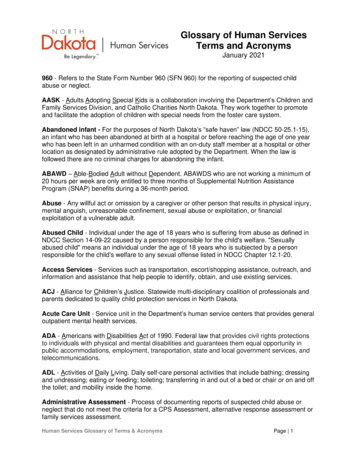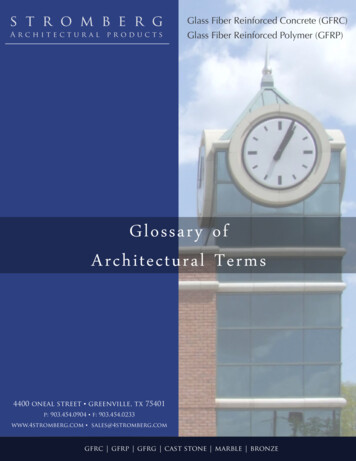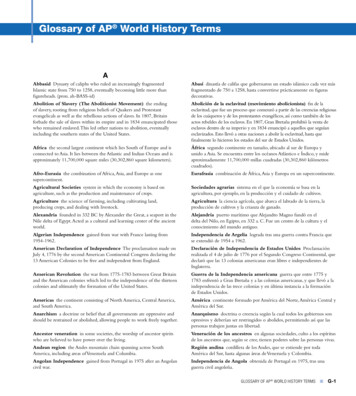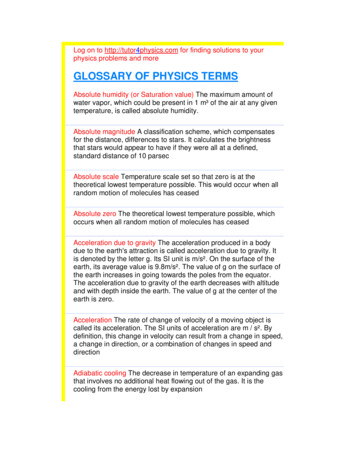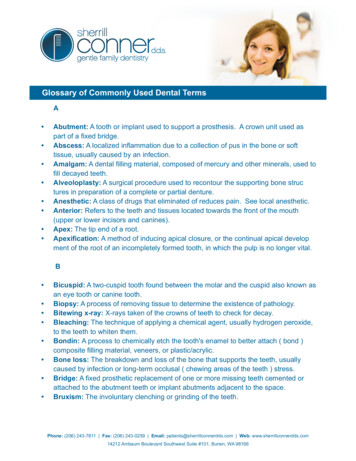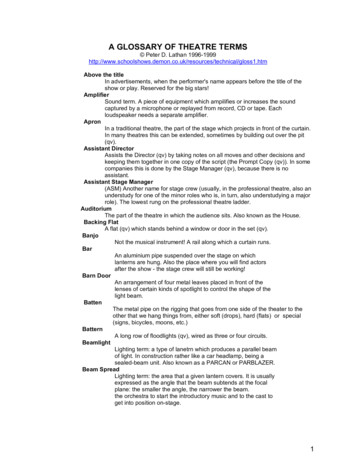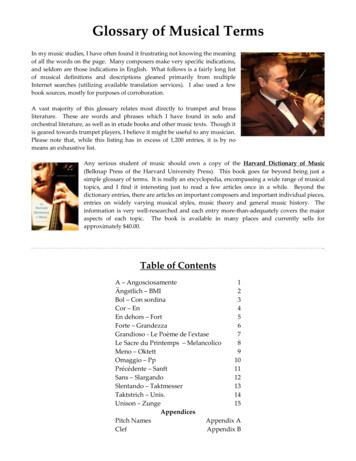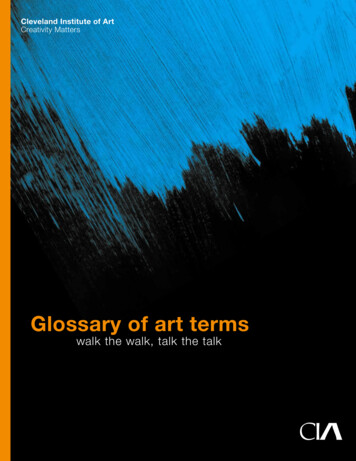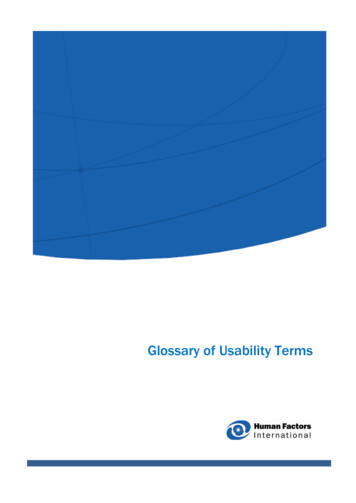
Transcription
Glossary of Usability Terms
Glossary of Usability TermsGlossary of Usability TermsTable of ContentsA . 3B . 7C . 10D . 15E . 18F. 20G . 21H . 23I . 26J . 28K . 29L . 29M . 32N . 34O . 35P . 35Q . 39R . 39S. 42T . 47U . 51V . 52W . 53X . 55Y . 56Z. 56
Glossary of Usability TermsAA4 Paper SizeA4 paper size A standard paper size(210 x 297 mm) widely used incountries using the metric system.A4 PaperA-B TestLive-site testing technique where a percentage of site visitorsare shown an alternate version of a design. The effectivenessof the two designs is then compared.Above-the-FoldFor Web pages, the area that is visible upfront before scrollingthe page. The term is derived from the space as seen on thefront page of a newspaper when folded in half. Mostimportant matter is placed above the fold.Revised 27-OCT-2014Page 3 of 56
Glossary of Usability TermsAccelerator KeysShortcut keystrokes that instantly perform an operation.Pressing "Ctrl" and then "M" in MS PowerPoint inserts a newslide.AccessibilityAccess to everyone regardless of disability. Barrier-free design.An area of expertise focused on delivering products toindividuals with disabilities, who may be using their ownassistive technology.Accordion MenuA navigation control where the user expands a navigationoption to see the sub-navigation options under it, collapsingany previously expanded navigation option.AccumulatorA graphic widget that allows the selection of multiple itemsfrom a list into a new functional group. Also called a listbuilder or add-remove controlAchromatopsiaMost severe form of color weakness. Achromatopsia (alsoknown as rod monochromatism) is true color blindness(individual has no cones), resulting in only the ability to seeblack, white, and shades of gray. It is not as common as othertypes of color weakness.AcronymA word such as “NATO” and “NASA” formed from the initialletter or letters of each of the successive parts or major partsof a compound term.Revised 27-OCT-2014Page 4 of 56
Glossary of Usability TermsActive VoiceA sentence structure where the subject performs the action ofthe verb and the object receives the action. For example, "Theuser selects the drop-down box." Active voice differs from thepassive voice wherein the subject receives the action, e.g.,"The drop-down box is selected by the user." (Also see PassiveVoice.)Adaptive DesignImplementation of designs that allows them to adapt todifferent form factors, such as PC, tablet, or mobile device.Delivered via pre-defined screen sizes (not fluid layout). Seealso “Responsive design”.Advanced PrototypeA reasonably detailed, full-scale, and usually working modelof a new application or Web site used to test the effectivenessof the application or site. (Also see Early Prototype.)Affinity DiagramA group decision-making technique designed to sort a largenumber of ideas, concepts, and opinions into naturally relatedgroups. Used in documenting task or content relationships,often created from card sort activities or group brain stormingAffordanceWhen a control behaves as its appearance suggests. Forexample, a push button is said to have good affordance whenit looks clickable. A pushbutton that does not look clickable ora non-clickable image that looks like a pushbutton, areexamples of poor affordance. Good affordance providesintuitive interaction.Aliasing / Anti-AliasingThe process of filling out the jagged edges of an image ortypeface with additional pixels. The color of the pixels isaveraged between the type color and the background. (Alsosee Anti-Aliasing.)Alignment PointsImplicit (not visible) vertical lines along which elements alignon an interface.Revised 27-OCT-2014Page 5 of 56
Glossary of Usability TermsALT TextALT text In HTML, a short text description of an image. It isadded to aid non-graphical browsers, and appears if the imagecannot be displayed.Analogous ColorsAny 3 consecutive color segments on the wheel.Anomalous TrichromatsA specific type of color weakness based on reduced sensitivityto green or red. Cones are activated by different proportionsof the three wavelengths than a normal trichromat(“standard” vision)Anti-AliasingThe process of filling out the jagged edges of an image ortypeface with additional pixels. The color of the pixels isaveraged between the type color and the background. (Alsosee Aliasing.)AliasingAnti-AliasingAnthropometryThe measurement of the human body size and distributions ofphysical dimensions in a population.AscenderAscender In typography, the upward vertical stem on somelowercase letters, such as "f" and "b," which extends abovethe x-height.Ascender line marks the top of ascendersRevised 27-OCT-2014Page 6 of 56
Glossary of Usability TermsAssistive TechnologyAny technology or product designed to assist an individualwith a disability in using a website or application. For example,a JAWS screen reader or VoiceOver iPhone app are assistivetechnologies.AttentionThe cognitive process of concentrating on one selected aspectof the environment while ignoring others.Auto CompleteA process whereby a drop-down list, combo box, or text entryfield fills in once the user has typed enough characters to havea complete match. (Also known as Auto Suggest)Auto CorrectA feature that corrects common and obvious input errors(such as spelling). It may ask the user to confirm the correctionif the error is uncommon or has more than one possiblecorrection.Auto TabA feature that automatically takes the cursor to the next textentry field after the user reaches the end of the previous fieldwithout having to hit "Tab."Cursor automatically moves to the next box after reaching theend of the previous box.BBaselineIn typography, the imaginary line upon which a line of textrests.Baseline marks the base of the text.Behavioral ResponseRevised 27-OCT-2014Actions performed by a person as a conscious reaction toexternal or internal stimuli. (Also see Visceral Response andReflective Response.)Page 7 of 56
Glossary of Usability TermsBelt and Suspender RuleA metaphor for using attributes one at a time. For example,make the header bold or increase the font size; not both.When using a belt, one doesn't need suspenders.Belt and suspender rule: To show font hierarchy, increase fontsize, or make text bold; not bothBenchmark TestingTesting an application against a set of standard best practicesor established criteria.BiasA one-sided viewpoint, inclination or a partial perspective. Aninterviewer might inadvertently bias an interviewee’s answersby asking a “loaded” question, in which a desired answer ispresupposed in the question.BiomechanicsThe study of the mechanical function and dynamics of themuscular-skeletal system.BitmappedA font or graphic image made up of a pattern of pixels in arectangular grid. Bitmaps are aliased (see Aliasing). The stairstep effect is produced by the square shape of the pixels, andenlarging such an image magnifies this effect. (Also seeVectored.)Bitmapped image and fontRevised 27-OCT-2014Vectored image and fontPage 8 of 56
Glossary of Usability TermsBounded Field /Unbounded FieldThe ability of a control to allow for freeform entry versusforced selection from a set of options. A bounded field (e.g.,list box) forces selections making it less error prone than a textentry field, which supports freeform entry. A text field with aformat mask gives the field a bounded quality, making it lesserror prone (e.g., date fields with format slashes).Bounded FieldBraille KeyboardBounded Field with Unbounded FieldFormat MaskA device that converts text from a computer application orWeb page into Braille, allowing a visually impaired person touse a computer.Braille TerminalBrandingThe deliberate process of creating individuality and marketvalue around the concept of a product name. Effectivebranding efforts enable companies to convey distinctivenessand value to their various audiences.Branding ElementsElements such as graphics, text, theme, etc. used to createbranding.Branding ElementsBreadcrumbsAn auxiliary form of navigation consisting of a trail of links,indicating where the user is in the site hierarchy, and alsoallowing the user to navigate back up one or more levels.Trail of links from the home page to the current pageRevised 27-OCT-2014Page 9 of 56
Glossary of Usability TermsCCanonic PerspectiveA standard, preferred or common way of viewing or depictingan object.Card SortingA technique to investigate how users tend to group. The usersare given a set of cards containing individual item names andare told to sort them into related piles and label the groups.Card sorting provides insight into the user's mental model andsuggests the structure and placement of items on a Web site.Card sorting technique to identify users' mental model ofinformation architectureCascading MenusA hierarchical menu system that appears as the user highlightsindividual items in the menu. The number of levels in thehierarchy can vary. A cascading menu hides site content andcan require a high degree of manual dexterity to manipulate,causing frustration as the number of levels increases.Cascading MenusCascading Style Sheets(CSS)A mechanism for specifying how a Web page looks withoutaffecting its HTML structure. Styles define attributes such ascolor, font size, alignment, and spacing. The term cascading isused because more than one Style Sheet can affect the samepage. CSS standards were created by the World Wide WebConsortium (W3C).CausationA relationship between an event (the cause) and a secondevent (the effect), where the second event is a consequenceof the first event.Revised 27-OCT-2014Page 10 of 56
Glossary of Usability TermsCheckboxA control, in the shape of a small box, used in forms or dialogboxes that users can check or uncheck to agree or disagreewith the text written next to it. Checkboxes are independentof other checkboxes (as opposed to radio buttons which aremutually exclusive). Thus the user can make multiple choicesfrom a group of selections.CheckboxChromatic AberrationThe blurring of colors in an image caused by the unequalrefraction of light rays of different colors passing through alens, whereby all the colors do not focus at a single point, e.g.,our eye cannot focus red and blue light on our retina, causingchromatic aberration.Chromatic Aberration with red and blue textChromostereopsisThe visual effect of vibration or floating when the eye isattempting to accommodate at extreme ends of the colorspectrum (e.g., when reds and blues are placed side by side).ChromostereopsisClick StreamThe trail of mouse clicks made by a user while performing aparticular task. It often refers to linking from one page toanother on the Web.Cognitive FrictionA term relating to the relative difficulty of a task and themental effort required to complete it. Tasks that presentchoices and actions in accordance to the user's expectationsare considered as having a low level of friction, while thosethat require deliberation are said to be high in cognitivefriction.Revised 27-OCT-2014Page 11 of 56
Glossary of Usability TermsCognitive ProcessingThe process of a user applying their knowledge, memory, andjudgment when experiencing a design, and then taking anactionCognitive WalkthroughA design evaluation in which team members review all screenelements in the context of various tasks (e.g., “How manyusers will click this button for task A? What happens whenthey do?”).ColorAlso known as Hue. Color is how different wavelengths ofvisible light are perceived by the eye. It is an attribute used todescribe the wavelengths of light reflected from an object.Cones are the color receptors in the eye.Color WeaknessA partial inability to distinguish or perceive colors. See alsoAchromatopsia, Anomalous Trichromats, ConeMonochromats, and Dichromats.Tool used by visual designers to make fundamental colorcombination choices.Color WheelCombo BoxA combination of a text entry field and a dropdown list toallow users to either select from existing options or type acompletely new entry.Drop-Down Combo BoxRevised 27-OCT-2014Page 12 of 56
Glossary of Usability TermsCommon AreaThe Gestalt principle of grouping that states that itemsgrouped within an area (e.g., using a background plane) tendto be perceived as belonging together.Grouping by Common AreaComparison TestsUsability test that compares two or more designs. Examplesmight be comparing alternative wireframes, comparing beforeand after designs, or a comparing a design against competitordesigns.Complementary ColorsColors that are directly opposite each other on the colorwheel.Computer ExpertiseAlso called Technological Expertise. A relative comfort withtechnology; adeptness while using a computer or advancedtechnology. (Also see Domain Expertise.)Concept SketchAn outline drawing to indicate ideas about how to solve aspecific design problem. It excludes the level of detail thatgoes into the final product. Concept sketches are used at thebeginning of the design process to quickly explore differentideas and to narrow down to an effective design.Concept SketchRevised 27-OCT-2014Page 13 of 56
Glossary of Usability TermsConceptual ModelA model constructed by the users in their mind to understandthe working or the structure of objects, based on their mentalmodel and previous experience, to speed up theirunderstanding. Also called mental model.Cone MonochromatsA specific type of color weakness resulting in people who canonly see one color. Blue cone monochromacy is characterizedby poor central vision and color discrimination.Confirmation BiasThe tendency to search for, notice, and interpret informationin a way that confirms one’s beliefs or opinions.ConnectednessThe Gestalt principle of grouping that states that itemsconnected with visual elements (e.g., lines) tend to beperceived as belonging together.Grouping by ConnectednessContent DesignA term given to a set of design areas that focuses on theinformation value of content, as opposed to the presentationof it. The content topics include editorial style,internationalization, and accessibility. The term content designintends to differentiate these topics from other topics forpurposes of evaluation and development.Content GraphicA type of graphic designed for the purpose of providingspecific content, as differentiated from graphics that addaesthetic value or brand value. Examples of content graphicsinclude complex charts, maps, and product photographs. Of allthe graphic types, content graphics are the most likely to serveas a destination in their own right, as opposed to a marker forentry into information (e.g., icon).Complex ChartRevised 27-OCT-2014MapProduct PhotographPage 14 of 56
Glossary of Usability TermsContext EffectThe effect of surrounding elements on the perceived meaningor use of an isolated element. For example, the meaning of anindividual link.The meaning of the word "Advanced" is perceived in contextwith "Search"Context Sensitive PopupMenuA short list of choices or instructions with information that iscustomized for a particular area of a program, appearing onscreen in a small window.Contextual InquiryA direct data gathering method in which the usability analystshadows an end user through their day/ tasks. Helpful fordeveloping a clear understanding of both the context of thetasks and a compressive environmental analysis.Conversion RatePercentage of users who take a specified action, such as signup for an account or purchase a productCookiesA small file with user-specific information that the serverwrites to the user’s hard disk for later access. Intended as amechanism for customization (remembering favoritepurchases and wish lists, storing shopping cart contents, etc.).CorrelationA statistical relationship between two variables or two sets ofdata. A correlation might be positive (as one variableincreases, the other increases) or negative (as one variableincreases, the other decreases). Note that correlation does notimply t
Glossary of Usability Terms . Pressing "Ctrl" and then "M" in MS PowerPoint inserts a new slide. Accessibility Access to everyone regardless of disability. Barrier-free design. An area of expertise focused on delivering products to indi

